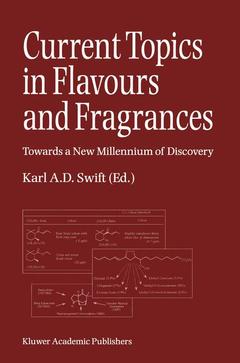Description
Current Topics in Flavours and Fragrances, 1999
Towards a New Millennium of Discovery
Coordinator: Swift K.A.
Language: English
Subjects for Current Topics in Flavours and Fragrances:
Keywords
Publication date: 11-2012
235 p. · 16x24 cm · Paperback
235 p. · 16x24 cm · Paperback
Description
/li>Contents
/li>
This book is designed to give the reader up to date infonnation on some of the more exciting developments that have taken place at the leading edge of fragrance and flavour research. Chapter one gives the reader a rnpid excursion through the chronological landmarks of fragrance and flavour materials and sets the scene for the remaining nine chapters which cover topics that are at the forefront of modem research. Chapter two looks at the total synthesis of synthetically interesting perfumery naturnl materials. This chapter aims to highlight the creative and elegant chemistry that has been performed by some of the worlds greatest chemists in their quest to synthesise one of the five naturnl products reviewed in the chapter. The chapter fits in with the forward looking theme of the book as it will hopefully inspire other chemists that are interested in synthesising natural products to produce elegant new, or industrially applicable routes to these and other perfumery materials. Chapter three looks at the growing area of interest in asymmetric fragrance materials. The chapter focuses on the use of the metal-BINAP catalytic system for the preparation of fragrance and flavour ingredients. Environmental considerations are now an integrnl and vital part of planning any new industrial chemical process. Chapter four aims to give the reader an insight into the wide-ranging and often readily applicable chemistry that is currently available for the installation of environmentally friendly chemical processes.
The Total Synthesis of Synthetically Interesting Perfumery Natural Products.- 1. Introduction.- 2. Vetiver Oil.- 3. Orris Oil.- 4. Patchouli Oil.- 5. Osmanthus Oil.- 6. Abbreviations.- 7. References.- Advances in the Transition Metal (Rh, Ru)-BINAP-Catalysed Asymmetric Synthesis of Chiral Compounds for Flavours and Fragrances and Their Associated Sensory Properties.- 1. Introduction.- 2. Asymmetric synthesis of chiral compounds for flavours and fragrances catalysed by (Rh, Ru)-BINAP complex and their associated sensory properties.- 3. Summary.- 4. Acknowledgements.- 5. References.- Towards Environmentally Friendly Chemical Processes.- 1. Introduction.- 2. The E-Factor and atom efficiency.- 3. The role of catalysis.- 4. Catalytic reduction.- 5. Catalytic oxidation.- 6. Catalytic C-C bond formation.- 7. Catalysis with solid acids and bases.- 8. Catalytic conversions in non-conventional media.- 9. Biocatalysis.- 10. Asymmetric catalysis.- 11. Concluding remaries.- 12. References.- Advances in the Industrial Synthesis of Medium to Large Ring Molecules.- 1. Introduction.- 2. Synthesis and macrocyclisation of bifunctional chains.- 3. Macrocycles via ring expansion.- 4. Macrocycles via cyclooligomerisation.- 5. Summary.- 6. References.- Analysis Technology.- 1. Introduction.- 2. Sample preparation.- 3. Qualitative analysis.- 4. Quantitative analyses.- 5. Data banks.- 6. Conclusions.- 7. Bibliography.- Flavour Matrix Interactions.- 1. Introduction.- 2. Interactions of volatile flavours with aqueous solutions.- 3. Interactions with starch.- 4. Oil-water partition.- 5. Interactions of volatile flavours with proteins.- 6. Encapsulation.- 7. Conclusion.- 8. Acknowledgements.- 9. Bibliography.- Biotransformations in the Flavour Industry.- 1. Summary.- 2. Introduction.- 3. Problems encountered in flavour biotransformation studies.- 4. Advantages of biotransformation.- 5. Toxicity / solvent tolerance.- 6. Genetic engineering: success and perspectives.- 7. Process development.- 8. Economic considerations.- 9. Acknowledgements.- 10. References.- Lipid Derived Flavours.- 1. Introduction.- 2. Non-enzymatic lipid oxidation.- 3. Enzymatic lipid oxidation.- 4. Lipids as a source of positive and negative flavours in food.- 5. References.- Safety and Legislation of Flavourings.- 1. Introduction.- 2. System of regulation.- 3. Definitions.- 4. Labelling.- 5. Suitable flavouring substances.- 6. Safety evaluation of flavouring substances.- 7. Future developments.- 8. References.
© 2024 LAVOISIER S.A.S.
These books may interest you

Understanding Natural Flavors 52.74 €



